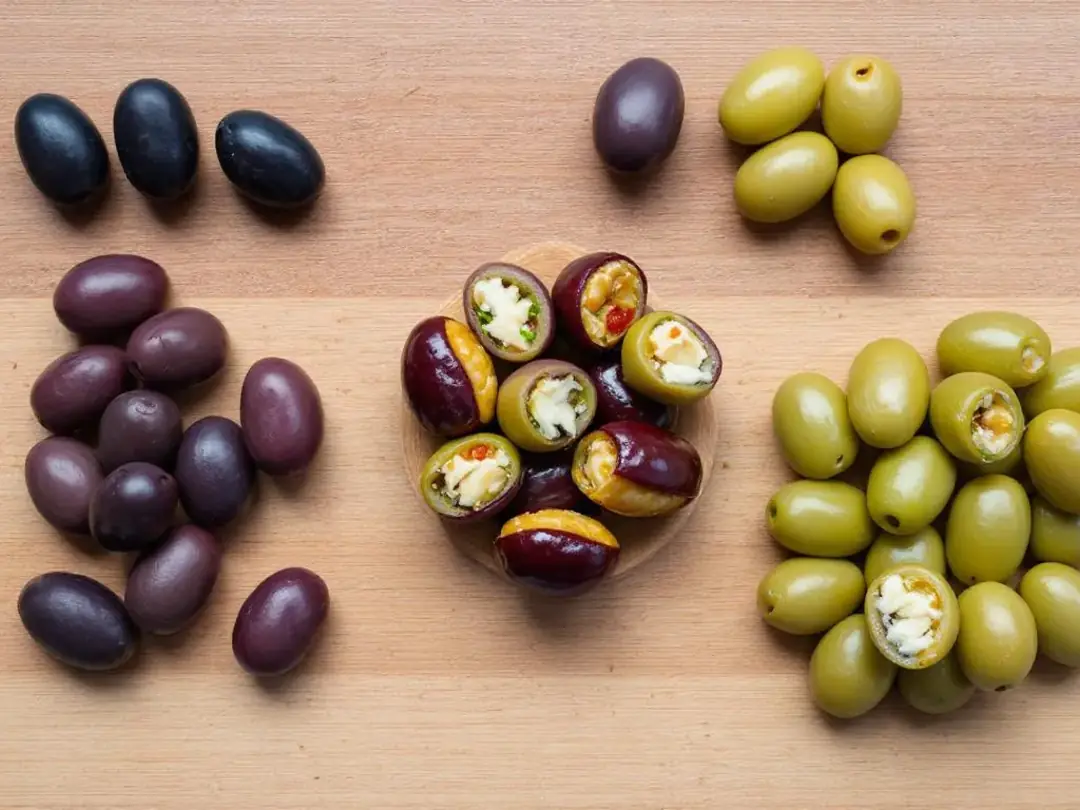Key Takeaways
-
Dogs can eat plain, pitted olives in small quantities as an occasional treat, but they are not toxic
-
Always remove olive pits before feeding to prevent choking hazards and intestinal blockages
-
Avoid olives with high sodium content, seasonings, garlic, or stuffing as these can be harmful to dogs
-
Olives should only be given in moderation due to their high fat and salt content
-
Consult your veterinarian before introducing olives to dogs with health conditions like pancreatitis or heart disease
-
As with certain foods, it is important to consider allergies, sensitivities, and health conditions before offering olives to your dog.
Introduction to Olives
Olives are a unique fruit that can offer some nutritional benefits when added thoughtfully to your dog's diet. Dogs eat olives on occasion, and when served properly, olives can provide healthy fats, essential vitamins, and important minerals. Both green olives and black olives are rich in monounsaturated fats, which support heart health and may help reduce inflammation. These healthy fats, along with vitamin E and antioxidants, can contribute to your dog's overall well-being.
If you're considering letting your dog eat olives, always opt for plain olives and be sure to remove any olive pits first. Olive pits can pose a serious choking hazard or cause digestive blockages, so only offer pitted olives to your pet. Introducing olives slowly into your dog's food allows you to watch for any adverse reactions, such as digestive upset or allergies.
In addition to whole olives, extra virgin olive oil can be a beneficial supplement for dogs. Olive oil is packed with monounsaturated fats and antioxidants, which can promote healthy skin and a shiny coat. However, as with any new food, moderation is key-too much olive oil or too many olives can lead to unwanted side effects. Always start with small amounts and observe your dog's response before making olives a part of their occasional treat rotation.
Are Olives Safe for Dogs?
Plain, unsalted olives are generally safe for dogs to eat when given in small amounts. Olives are non toxic to dogs, but preparation and moderation are key to ensuring they remain a safe treat. However, this doesn't automatically make them a good choice for your pet's diet.
Offering one or two plain, pitted olives occasionally is a safe amount for most healthy dogs. The key lies in preparation and moderation. Dogs eating olives face risks primarily from what's added during processing-high sodium levels, seasonings, and preservatives that can cause problems.
Dogs with kidney disease, heart conditions, or pancreatitis should avoid olives completely. The high sodium and fat content can worsen these health conditions and potentially trigger serious complications. Even healthy dogs need careful portion control since olives pack significant calories and sodium into small packages.
Always supervise dogs when giving olives to monitor for any adverse reactions. Some dogs may experience digestive upset even from plain olives, especially if they have sensitive stomachs or aren't used to new food additions.


Types of Olives and Their Safety for Dogs
Green olives are safe for dogs in moderation when plain and pitted. These unripe olives typically have a firmer texture and more pronounced flavor than their black counterparts. When dogs eat green olives, they're getting the same basic nutritional profile-healthy fats, vitamin E, and unfortunately, often high sodium levels.
Green Olives
Avoid green olives with garlic stuffing or excessive salt content. Many commercial green olives come stuffed with ingredients that are toxic to dogs or packed in heavy brines that spike sodium levels dangerously high. Garlic, commonly used in stuffed varieties, can cause hemolytic anemia in dogs.
Choose fresh or water-packed green olives over brined varieties whenever possible. Rinse store-bought olives thoroughly to remove excess salt before offering them to your dog. This simple step can significantly reduce the sodium content.
Limit portions based on your dog's size: 1-2 olives for small dogs, 2-3 for medium dogs, and 3-4 for large dogs per serving. Remember, this should be an occasional treat, not a regular addition to your dog's food.
Black Olives
Black olives are equally safe as green olives when served plain and pitted. These ripe olives tend to be milder in flavor and may be more appealing to dogs who find green olives too bitter. The nutritional value remains similar between varieties.
Canned black olives often contain high sodium levels and should be avoided or thoroughly rinsed. The canning process typically involves salt-heavy brines that concentrate sodium to levels far exceeding what's appropriate for dogs. Always check labels for sodium content-some varieties contain up to 900mg per 100g.
Fresh black olives are preferable to processed varieties when available. If you have access to olive trees or specialty markets selling fresh olives, these represent the lowest-sodium option for your dog.
The same portion guidelines apply as with green olives based on dog size. Whether your dog eats black olives or green ones, moderation remains crucial for preventing digestive upset and sodium overload.
Stuffed Olives
Never feed dogs olives stuffed with garlic, blue cheese, or pimento peppers. Stuffed or seasoned olives can make olives bad for dogs because they often contain toxic or harmful ingredients, such as garlic, excess salt, or other additives. These popular stuffing ingredients pose serious health risks that far outweigh any potential benefits from the olive itself.
Garlic is toxic to dogs and can cause serious health complications including hemolytic anemia, where red blood cells break down faster than the body can replace them. Even small amounts of garlic can be dangerous, and stuffed olives often contain concentrated garlic preparations.
Blue cheese contains compounds that are harmful to canines. The roquefortine C found in blue cheese can cause vomiting, diarrhea, and potentially seizures in dogs. Additionally, the high fat content in cheese can trigger pancreatitis in susceptible dogs.
Stick to plain, unstuffed olives to ensure safety. When in doubt, choose the simplest preparation possible. Plain olives might be less exciting for human palates, but they're the only safe option when sharing with your pet.
Olives in Brine
Brined olives contain extremely high sodium levels dangerous for dogs. The brining process, which makes olives palatable for humans, creates a sodium concentration that can quickly overwhelm a dog's system. Dogs fed high-sodium foods regularly can develop serious health problems.
Excessive salt can lead to dehydration and salt toxicosis in dogs. This condition occurs when sodium levels in the blood become dangerously elevated, potentially causing neurological symptoms and organ damage. Large dogs may tolerate slightly more sodium, but small dogs are particularly vulnerable.
Rinse brined olives thoroughly or choose water-packed alternatives when possible. If you only have brined olives available, extensive rinsing can reduce some of the sodium content, though it won't eliminate it entirely.
Signs of salt poisoning include vomiting, diarrhea, excessive thirst, and lethargy. If your dog shows these symptoms after eating salty foods, contact your veterinarian immediately. Quick treatment can prevent serious complications.
Dog's Diet and Olives
When thinking about your dog's diet, it's important to remember that while dogs can eat olives, these should only be offered as a healthy treat in small quantities. The foundation of your pet's nutrition should always be a complete and balanced diet, typically provided by high-quality commercial dog food. Olives, especially unsalted and plain olives, can be a tasty and healthy snack, but they should never replace your dog's regular food.
If you want to let your dog eat olives, choose unsalted olives over brined or cured varieties, as brined olives often contain too much sodium, which can be harmful to dogs. Offering a few olives-such as one or two plain olives-as an occasional treat is generally safe for most healthy dogs. However, too many olives can cause digestive upset, so it's best to limit the amount and frequency.
Avoid giving your dog stuffed olives or any olives containing toxic ingredients like garlic or blue cheese, as these can be dangerous to your pet's health. Always monitor your dog for any signs of digestive issues or adverse reactions after introducing new foods. Consulting with your veterinarian is the best way to ensure that adding olives to your dog's diet is safe, especially if your dog has existing health conditions. By keeping olives as an occasional treat and focusing on a balanced diet, you can help support your dog's overall well-being and health.
Olive Oil for Dogs
Extra virgin olive oil can benefit dogs when used sparingly. Unlike whole olives, olive oil eliminates concerns about choking hazards and provides concentrated healthy fats without the sodium issues that plague prepared olives.
Olive oil contains monounsaturated fats that support healthy skin and coat. These fats, particularly oleic acid, can help reduce inflammation and improve the appearance of your dog's fur. Many commercial dog foods already include olive oil or similar beneficial oils.
Start with 1/4 teaspoon for small dogs and 1 teaspoon for large dogs when introducing olive oil to your pet's diet. This conservative approach allows you to monitor your dog's tolerance and avoid digestive upset from too much fat too quickly.
Excessive olive oil can cause pancreatitis and digestive upset. Dogs with sensitive stomachs or previous pancreatitis episodes should avoid olive oil completely. Even healthy dogs can develop loose stools or stomach upset from too much added fat in their diet.
Dogs with pancreatitis should avoid olive oil completely. The high fat content can trigger painful flare-ups and potentially lead to serious complications requiring veterinary intervention. Always consult your veterinarian before adding olive oil to a dog's diet if they have any health conditions.
Potential Risks and Health Concerns
High sodium content can worsen kidney and heart conditions in susceptible dogs. Many dogs develop kidney or heart problems as they age, making them particularly vulnerable to sodium overload. High sodium and fat content in olives can also exacerbate existing health issues in dogs, such as high blood pressure or pancreatitis. Even dogs without diagnosed conditions can experience problems from consistently high sodium intake.
Olive pits pose serious choking hazards and can cause intestinal blockages. These hard seeds are exactly the right size to lodge in a dog's throat or digestive tract. Emergency surgery may be required to remove impacted pits, making this risk particularly serious for pet owners to consider.
High fat content may trigger pancreatitis in predisposed dogs. Pancreatitis causes severe abdominal pain and can be life-threatening if not treated promptly. Dogs with previous episodes, overweight dogs, and certain breeds like miniature schnauzers face higher risks.
Some dogs may be allergic to olives, causing skin irritation or digestive issues. Food allergies in dogs often manifest as itchy skin, ear infections, or gastrointestinal upset. If your dog shows these symptoms after eating olives, discontinue feeding them immediately.
Overconsumption can lead to obesity due to calorie density. Olives contain approximately 150 calories per 100 grams, which represents a significant portion of daily caloric needs for small dogs. Regular olive treats can contribute to weight gain if not accounted for in the overall diet.


What to Do If Your Dog Ate Olives
Monitor your dog closely for 24-48 hours after olive consumption, especially if your dog has eaten olives. Most dogs will show symptoms within this timeframe if they're going to have problems. Keep a log of your dog's behavior, appetite, and bathroom habits to help identify any changes.
Watch for symptoms like vomiting, diarrhea, excessive thirst, or lethargy. These signs can indicate either sodium toxicity or general digestive upset. Excessive thirst combined with increased urination often signals sodium overload, while vomiting and diarrhea might indicate fat intolerance.
Contact your veterinarian immediately if your dog consumes pitted olives or large quantities of any olives. Olive pits require immediate attention due to choking and blockage risks. Large quantities of olives can cause salt poisoning, which becomes more dangerous the longer treatment is delayed.
Seek emergency medical attention if your dog ate olives with garlic or shows severe symptoms. Garlic toxicity can cause serious blood cell damage that worsens over time. Severe symptoms like difficulty breathing, collapse, or persistent vomiting warrant immediate veterinary attention.
Provide your vet with details about the type and quantity of olives consumed. This information helps determine the level of risk and appropriate treatment. Include details about stuffing, brining, and any other ingredients that might have been present.
Safe Guidelines for Feeding Olives to Dogs
Always remove pits completely before offering olives to dogs. This single step eliminates the most serious immediate risk associated with dogs eating olives. Check each olive carefully, as some pits may be cracked or partially removed during processing.
Choose plain, unsalted varieties without added seasonings or preservatives. Read ingredient labels carefully, as even "plain" olives may contain unexpected additives. Water-packed olives typically have lower sodium content than oil-packed or brined varieties.
Limit frequency to once or twice per month as an occasional treat. Olives should only be a small, occasional part of your pet's diet and should never replace balanced nutrition. Olives should never become a regular part of your dog's diet. Think of them as you would any high-sodium, high-fat human food-something to share very sparingly.
Start with half an olive to test your dog's tolerance before offering a full piece. Some dogs have more sensitive digestive systems than others. This approach lets you gauge your individual dog's reaction without risking significant upset.
Never replace regular dog food with olives as they lack essential nutrients dogs need for optimal health. Commercial dog food provides complete and balanced nutrition specifically formulated for canine needs. Olives offer minimal nutritional benefits that justify their risks. Puppies under 6 months should not be given olives due to developing digestive systems.
Young dogs are more sensitive to dietary changes and have lower tolerance for high-sodium or high-fat foods. Focus on puppy-specific treats designed for their developmental needs and help others learn what you now know. Can Dogs Eat Olives?
Healthier Alternative Treats for Dogs
Rather than wondering whether dogs can eat olives, consider these safer alternatives that provide better nutritional value for your pet. These options offer health benefits without the sodium and fat concerns that make olives problematic.
Blueberries provide antioxidants without high sodium content. These small fruits are packed with vitamins and minerals that support immune system function. Most dogs enjoy their sweet taste, and they're naturally low in calories.
Carrots offer vitamins and help clean teeth naturally. The crunchy texture provides dental benefits while delivering beta-carotene and fiber. Cut them into appropriate sizes to prevent choking, especially for smaller dogs.
Apple slices (without seeds) provide fiber and vitamins that support digestive health. Remove all seeds before offering apples, as they contain compounds that can be harmful to dogs. The natural sweetness makes them appealing to most pets.
Plain cooked sweet potato contains beneficial nutrients and fiber without added sodium or preservatives. This orange vegetable provides beta-carotene, potassium, and vitamins that support overall health. Serve it cooled and cut into appropriate portions.
Commercial dog treats specifically formulated for canine nutrition represent the safest option for regular treats. These products undergo testing to ensure they meet nutritional standards and safety requirements for dogs. Look for treats made with high-quality ingredients and minimal processing.
FAQ
Can puppies eat olives?
Puppies should avoid olives due to their high sodium content and developing digestive systems. Young dogs are more sensitive to salt and fat, making olives potentially harmful to their health. Their kidneys and digestive systems are still maturing, which means they have less ability to process high-sodium foods safely. Focus on puppy-specific treats designed for their nutritional needs instead. These treats are formulated to support proper growth and development without overwhelming immature organ systems.
How many olives can a 50-pound dog safely eat?
A 50-pound dog can safely consume 3-4 plain, pitted olives as an occasional treat. This should only happen once or twice per month, not regularly. Even for larger dogs, olives should remain a rare indulgence due to their high sodium and fat content. Always monitor for any digestive upset after feeding olives, and reduce the amount if your dog shows any signs of stomach discomfort. Remember that treats should never exceed 10% of your dog's daily caloric intake.
Are Kalamata olives safe for dogs?
Kalamata olives are generally safe if they are plain and pitted, following the same guidelines as other olive varieties. However, many Kalamata olives are cured in high-salt brine, making them unsuitable for dogs without thorough rinsing. These Greek olives often undergo extensive processing that increases their sodium content significantly. Check the preparation method and sodium content before offering to dogs. When in doubt, choose water-packed varieties or rinse thoroughly to remove excess salt.
Can dogs eat olive tapenade?
Olive tapenade is unsafe for dogs as it typically contains garlic, anchovies, and high salt levels. These ingredients can be toxic or harmful to canine health. Garlic can cause hemolytic anemia, while anchovies add excessive sodium and fish proteins that may trigger allergic reactions. The concentrated nature of tapenade means even small amounts deliver large doses of problematic ingredients. Stick to plain, individual olives rather than prepared olive products when considering treats for your dog.
What should I do if my dog ate an olive pit?
Contact your veterinarian immediately as olive pits can cause choking or intestinal blockage. Do not induce vomiting unless specifically instructed by a veterinary professional, as this could cause the pit to become more firmly lodged. Monitor for signs of distress including difficulty swallowing, vomiting, or inability to defecate. Time is critical with foreign object ingestion, so don't wait to see if the pit passes naturally. Your veterinarian may recommend X-rays to locate the pit and determine the best treatment approach.






